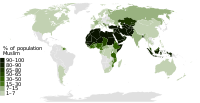Our website is made possible by displaying online advertisements to our visitors.
Please consider supporting us by disabling your ad blocker.
Islam in Lebanon
 Mohammad Al-Amin Mosque during 2019 Lebanese revolution | |
| Total population | |
|---|---|
| 2-3.5 million[1] | |
| Religions | |
| Shia Islam, Sunni Islam, Alawite |
| Islam by country |
|---|
 |
|
|
Islam in Lebanon has a long and continuous history. According to a 2020 estimate by the CIA, it is followed by 69.3% of the country's total population.[3] While a 2022 study by Pew Research puts the number of Muslims in Lebanon at 57.6%.[4] According to the CIA study, Sunnis make up 31.9% while Twelver Shia make up 31.2%.[5] next to smaller percentages of other Shia branches, such as Alawites and Ismailis. The Druze is sometimes designated as one of the five Lebanese Muslim communities (Sunni, Shia, Druze, Alawi, and Ismaili),[6][7] even though most Druze do not identify as Muslims,[8][9][10][11][12] and they do not accept the five pillars of Islam.[13]
Under the terms of an agreement known as the National Pact between the various political and religious leaders of Lebanon, the president of the country must be a Maronite, the Prime Minister must be a Sunnite, and the Speaker of Parliament must be a Shiite.
- ^ "2012 Report on International Religious Freedom - Lebanon". United States Department of State. 20 May 2013. Retrieved 15 December 2013.
- ^ "The World Factbook". Cia.gov. Retrieved 30 September 2020.
- ^ "Lebanon: people and society"
- ^ "Religious Composition By Country". pewresearch.org. 21 December 2022. Retrieved 2023-03-26.
- ^ "Lebanon: people and society"
- ^ Lebanon Country Study Guide Volume 1 Strategic Information and Developments. Ibp USA. 2009-06-07. ISBN 9781438774824. Retrieved 2019-04-24.[permanent dead link]
- ^ Lebanon Country Study Guide Volume 1 Strategic Information and Developments - Google Books. Ibp USA. 2009-06-07. ISBN 9781438774824. Retrieved 2019-04-24.[permanent dead link]
- ^ Pintak, Lawrence (2019). America & Islam: Soundbites, Suicide Bombs and the Road to Donald Trump. Bloomsbury Publishing. p. 86. ISBN 9781788315593.
- ^ Jonas, Margaret (2011). The Templar Spirit: The Esoteric Inspiration, Rituals and Beliefs of the Knights Templar. Temple Lodge Publishing. p. 83. ISBN 9781906999254.
[Druze] often they are not regarded as being Muslim at all, nor do all the Druze consider themselves as Muslim
- ^ "Are the Druze People Arabs or Muslims? Deciphering Who They Are". Arab America. 8 August 2018. Retrieved 13 April 2020.
- ^ J. Stewart, Dona (2008). The Middle East Today: Political, Geographical and Cultural Perspectives. Routledge. p. 33. ISBN 9781135980795.
Most Druze do not consider themselves Muslim. Historically they faced much persecution and keep their religious beliefs secrets.
- ^ Yazbeck Haddad, Yvonne (2014). The Oxford Handbook of American Islam. Oxford University Press. p. 142. ISBN 9780199862634.
While they appear parallel to those of normative Islam, in the Druze religion they are different in meaning and interpretation. The religion is considered distinct from the Ismaili as well as from other Muslims belief and practice... Most Druze consider themselves fully assimilated in American society and do not necessarily identify as Muslims..
- ^ De McLaurin, Ronald (1979). The Political Role of Minority Groups in the Middle East. Michigan University Press. p. 114. ISBN 9780030525964.
Theologically, one would have to conclude that the Druze are not Muslims. They do not accept the five pillars of Islam. In place of these principles the Druze have instituted the seven precepts noted above..
Previous Page Next Page


